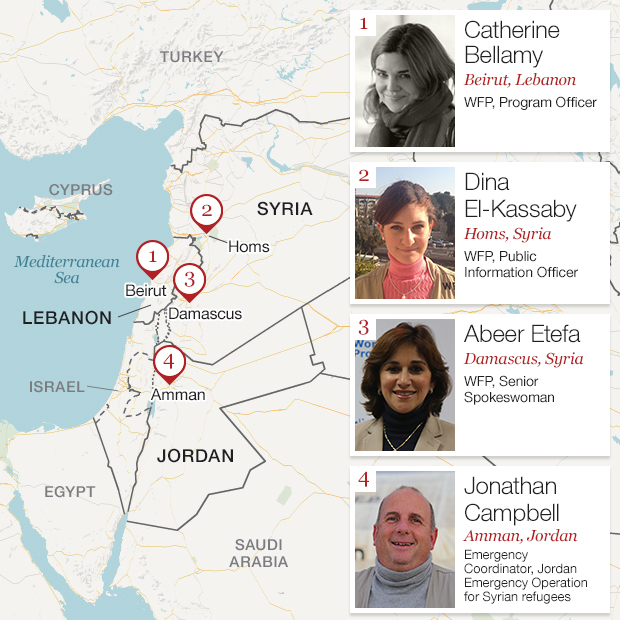As Syria war enters year 4, aid workers struggle to help millions displaced by fighting
Along with other non-governmental groups, the World Food Program (WFP) has been working in areas inside Syria where the bombs are still falling. Outside Syria's borders, the crisis has seen entire new cities -- populated completely by war refugees -- literally rise out of the dust, and coordinating aid for these displaced masses is a herculean task.
Syria is now the world's leader in forced displacement, with 9 million people having fled their homes.
The WFP is the largest aid organization working on the Syrian crisis, and has been on the ground delivering food since the beginning of the conflict.
"This is the biggest and most complex operation we have ever had," Bettina Luescher, WFP's Chief Spokesperson for North America, told CBS News.
The organization tries to provide food assistance to 4.2 million people every month with a staff of just 470 people inside Syria and the affected countries, including Lebanon, Jordan, Turkey, and Iraq.
CBS News spoke with WFP workers inside and outside Syria.
Inside Syria
El-Kassaby works in the sprawling northern city of Homs and surrounding areas. She describes locations like Homs' battered Baba Amr district as ghost towns, where bullet-ridden buildings are barely standing and many streets are deserted.
Recently, the WFP was able to reach several areas in Homs that were inaccessible for months due to fighting.
One of the locations included Al-Houle in rural Homs, where they delivered food for 20,000 people.
Food distribution in the country comes in the form of boxes full of staple items like rice, bulgur wheat, lentils, canned beans and oil. Each box is supposed to last one family about a month.
Although not as drastic as Homs, the capital city of Damascus has also gone through a transformation.
"Today when you walk in the city, especially after dark, it's pitch black. The power cuts are very frequent," Etefa said. "There is the absence of tourists. No one is here. Many shops have closed in the the major central area."
The situation is "becoming more grim," she observed."The ability of people to continue to cope with this conflict, getting into the fourth year, is really being exhausted. Families are telling us they are seeing more and more difficult days providing the needs for their families," said Etefa.
The besieged district of Yarmouk, comprised almost entirely of Palestinian refugees, in Damascus has been caught up in some of the worst fighting in this war, leading to severe food shortages.
United Nations Relief and Works Agency (UNRWA)'s aid shipments have had trouble getting into Yarmouk camp.
"Those who managed to reach our food distribution point -- I witnessed this myself during my visit -- emerged from the narrow streets looking more like ghosts than living people," said Filippo Grandi, the Commissioner General of UNRWA this month.
The camp was home to about 160,000 Palestinians. Around 20,000 are still trapped there.
Outside Syria
The U.N. cites Lebanon as having the highest concentration of refugees in the world.
In a country that is already densely populated, Bellamy said the situation is getting harder for the Lebanese people as well as the refugees.
There is competition over jobs a nd many services have taken a hit.
"The healthcare system, the educational system, the electricity, these are all things that the government of Lebanon has been very generous in providing, but given the fact that there's a lot of poor Lebanese in need, that we are starting to see some of those services suffer," said Bellamy.
Lebanon also does not have established camps, so the refugees live among the Lebanese people. Outside the city of Beirut many Syrians are living in tent settlements.
Syrian refugees in Lebanon are provided prepaid electronic vouchers by WFP that can be used at around 300 shops throughout the country. The cards amount to around 30 dollars per person per month.
Around 1.5 million Syrian refugees depend on the U.N. food agency's food vouchers.
Right now Jordan uses paper vouchers, but will be moving toward the electronic cards as well.
Unlike Lebanon, Jordan does have an established camp for the Syrian refugees.
There are almost 600,000 registered refugees in Jordan. According to WFP, 80 percent are scattered in towns and villages across Jordan.
A second camp is currently being built about an hour and a half from the capital, Amman, on the road toward the Iraqi border. It will shelter another 130,000 people.
Many Syrian refugees in Jordan have expressed a longing to return home.
"I think there's a long, deeply held wish to go back. And many people have told me, for example, I would rather die in a tent in Syria than in a palace in Jordan," said Jonathan Campbell, WFP Emergency Coordinator, Jordan Emergency Operation for Syrian refugees.
Still, he said, "They are keen in trying to make the most of their time here. We are seeing more and more children coming back to school as they realize the children need to be educated, that they are not going to be able to go back to the schools in Syria."
Amid the struggle to cope with the huge influx of refugees, and the unpredictability of food distribution because of security concerns inside Syria, the WFP is constantly seeking public contributions to try and keep its coffers full.
This year, the agency has said it must help 7 million people inside and outside Syria.



